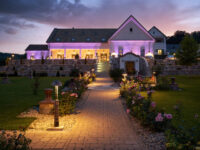How to Get the Best Out of Carpet Cleaning
Carpet Cleaning Lehi removes dirt, dust mites, allergens, and other contaminants trapped in your carpet. Professional cleaning services use specialized equipment and detergents to ensure your carpet looks great and smells clean!
Addressing spots and stains promptly will help reduce the risk of permanent color change. Blot liquid spills with dry white cloths or paper towels (no printed ink or colors) to avoid dye transfer when possible.
There are a variety of tough stains that can plague carpets, from wine and pet urine to blood, grease, and ink. The good news is that simple home remedies are often enough to tackle the problem. Liquid stains can be treated with a mixture of water and liquid dish soap, but don’t rub the spot, as this will push the stain deeper into the fibers. Instead, blot the stain repeatedly with clean white paper towels or microfiber cloths to soak up as much liquid as possible.
Once the area has been thoroughly soaked up, apply the cleaning solution as directed on the label (if you’re using a homemade cleaner) or spray the surface with plain water. Again, blot with clean white cloths and change them frequently to avoid the cloths reacting with dye from the carpet or cleaning product and transferring it to the new areas of the stain.
For old stains that seem to be reappearing, the culprit may be “wicking.” This occurs when the original spill has soaked through the carpet, into the backing, and sometimes even the pad. When it dries, the spill is reabsorbed into the carpet and can travel back up the fiber strands to the surface like a candle’s wick. This is why treating a stain as soon as it happens is important.
Other stain-fighting tips include club soda and hydrogen peroxide. Club soda can be sprayed on the stain and allowed to sit for a few minutes. Then, blot with a paper towel or cloth until the spot is nearly dry. Follow with plain white vinegar, then sprinkle the affected area with salt. Vacuum the area, and the stain should be gone.
For stubborn, ground-in stains that aren’t removed with these methods, you may need to hire a professional for hot water extraction, which is the most effective way to get rid of tough stains from most carpets. When you do, please find a local company that uses a truck-mounted unit rather than a portable machine, so they’re better equipped for handling the high-powered steam required for a deep clean.
Delicate fabrics in carpets need special care to keep them looking their best. They are typically thin and made from fine, fragile fibers that can easily be damaged by harsh cleaning products or techniques such as scrubbing. Preventive and restorative methods can help them withstand everyday wear and tear without fading or discoloring.
Vacuuming regularly helps keep debris and dirt from becoming embedded in delicate carpets. This keeps them soft and can also eliminate fresh stains before they become too severe. The vacuuming device must have a low suction setting and a brush that won’t pull out or damage the delicate fibers.
Regular spot cleaning with a mild detergent is essential for delicate fabrics, as is blotting the area immediately after spilling or dropping something on the floor. If a stain is allowed to soak in, it can cause permanent damage to the delicate fabric. Always use a small amount of detergent that is safe for the type of carpet you are cleaning, and never scrub an area with a rough cloth or sponge.
Using a lint roller is a great way to remove small, loose dirt particles that can quickly become embedded in delicate fabrics such as silk or cotton. This is especially helpful for food crumbs, broken crayons, and waxy residues from candle drippings. You can also heat waxy substances such as candle drippings to loosen them from carpet fibers and then wipe them away with a warm iron.
Water-repellent sprays and sealants are another important preventative measure for fragile carpets. These products prevent dry soil from bonding to the carpet, rugs, or fabric, so when it is vacuumed, more dry soil is removed, and less is deposited back on the surface.
To further protect delicate fabrics, they should be protected from direct sunlight. Dark drapes and curtains can block out light and help prevent fading or discoloration. It’s also a good idea to place furniture pads or coasters under heavy pieces to distribute weight evenly and avoid indentations and carpet fibers crushing.
Try a higher-end carpet shampoo if your regular cleaning needs to get the desired results. These products often have a stronger formula that removes tougher stains and prevents them from returning. These solutions can be poured into the tank of your machine or applied topically as a spot treatment. They can also be used with pretreatment sprays to help eliminate oil and water-based stains, such as food or beverage spills, that regular cleaners cannot remove.
A good quality product will typically have a low pH, leaving the fibers in their natural state rather than an acidic one, says Karina Toner, operations manager of Spekless Cleaning. It should also have a low concentration of surfactants and chemicals that break down oils and other soils. It’s also important to choose a formula that is compatible with the materials and fibers of your carpeting, says Toner.
This plant-based cleaner was a hit with 2022 Good Housekeeping Best of the Best testers, who loved its simple application: just spritz, wait 10 minutes, and blot. It also dispenses neatly so that you can target specific spots without a lot of overspray. Best of all, it effectively removed even long-standing stains from wool carpeting and upholstery. It also has a nice, refreshing — but not overpowering — spearmint and sage scent.
This solution’s hydrogen peroxide and other surfactants emulsify tough soil, including sand, that normal pre-sprays might not remove. Then, it uses a polymer to keep stains from returning, leaving your carpet clean and fresh. This is a great option for those in high-traffic areas and pet owners who need something to prevent browning, wicking, and re-soiling. It’s also safe for the environment and contains no optical brighteners, which are toxic to the environment and the eyes, nose, and throat of animals and humans. It’s made of all-natural ingredients and is biodegradable. It’s also free of petroleum, phosphates, dyes, and phthalates. It’s made by a family-owned company that specializes in natural products.
Carpets are soft and comfortable and add warmth to a room, but they tend to trap dust, dirt, and allergens like pet dander. This can lead to respiratory problems and other health issues for anyone living in the home. A professional carpet cleaner can remove these nasties and leave your floor covered and fresh.
However, carpet cleaning is a complex job that requires the person carrying it out to be careful. There are a lot of different chemicals involved in this process, all of which can cause harm if they come into contact with the skin or eyes. It’s also important to ventilate the room adequately and use appropriate gloves and protective equipment when handling these chemicals. Inhaling the fumes can cause various health issues, from minor irritation to serious organ damage, especially in poorly ventilated areas.
Using the wrong chemicals for a given type of stain can cause lasting damage to your flooring. Moreover, only some detergents suit some stains, and some require specialized removal tools. For instance, some wine stains may need to be treated with a mixture of acids and solvents only a specialist can handle.
Several other safety concerns are associated with carpet cleaning, including improper handling and storage of cleaning agents and environmental contamination. Chemicals should be stored in a safe place out of reach of children and pets and disposed of in a manner that follows local regulations.
Choosing a professional service that is familiar with all the possible pitfalls of carpet cleaning and knows how to prevent them is important. A good technician will test all products on a small area of your carpet before proceeding, and they will thoroughly dry the floor underneath. This will ensure that your carpet is protected from water and detergent residue that could lead to mold growth, mildew, or other damage to the carpet’s backing or fibers. It’s also important to move furniture away from the carpet during drying and keep children, pets, and soiled shoes off the damp carpet until it’s fully dry.





